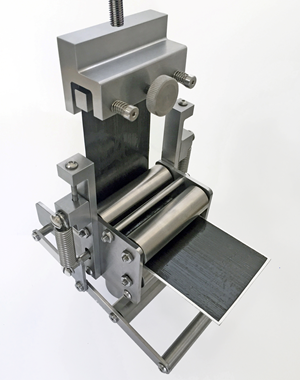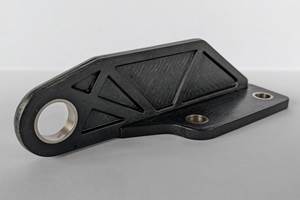New Lightweight Trailer Delivers Heavy-duty Performance
All-composite chassis and trailer design offers truckers increased cargo capacity plus greater durability.
Hauling freight by truck is a huge international industry. Retailers, manufacturers and the farm/food industry all depend on over-the-road truck shipments. According to the American Trucking Association, 2.6 million big rigs logged more than 200 billion miles in the U.S. alone, in 2000. Yet, despite these volumes, haulers face a very competitive market, with expensive vehicles and trailers and the necessary costs of ongoing maintenance and repair. In many areas, total vehicle weight restrictions often mean that truckers must limit load size, which reduces the revenue for each trip.
Truck manufacturer Stevens Carrosserie N.V. (Lokeren, Belgium), which was established in the 1870s to make horse-drawn wagons, spun off its Composittrailer N.V. group, headed by Jan Verhaeghe, in 1993 to develop an all-composite big-rig trailer for more cost-effective freight hauling. The group reasoned that a lighter trailer would reduce overall vehicle weight, which would mean more cargo could be hauled per trip, reducing the cost of the transported goods. Their concept was a trailer made entirely of pultruded profiles, filament-wound structures and resin transfer molded (RTM) elements. In the U.S., Martin Marietta Composites Inc. (MMC, Raleigh, N.C., U.S.A.) had a similar idea, approached Composittrailer and eventually worked out a licensing agreement, enabling MMC to manufacture trailers for the North American market while Composittrailer supplies the European market.
"The only non-composite parts on the trailer are the axles, the wheels and tires, wiring harness, the drive system for the moving floor, the king pin [the connection point between the trailer and the tractor] and the landing gear legs," says MMC's vice president Grant Godwin. "We've taken the European technology, reanalyzed and optimized the design for a U.S. trailer, which is 6 ft longer and has two axles instead of three." Godwin says the composite trailer is targeted to haulers of heavy bulk goods, like agricultural products (e.g., potatoes), wood chips, or waste, who tend to reach mandated maximum loads before the trailer is full.
FINITE ELEMENT MODELING DIRECTED DESIGN
The design process started in Belgium with analysis of a conventional steel trailer and typical cargo loads, usually between 20 and 22 metric tonnes (44,000 to 48,400 lb). NE/Nastran finite element analysis (FEA) software from Noran Engineering (Los Alamitos, Calif., U.S.A.) was used to help define the composite materials and fiber architecture to meet the anticipated loads. Twenty-six load cases were input to the model, which had 1.8 million degrees of freedom.
Composittrailer wanted to fabricate the components cost-effectively, so pultrusion and filament winding were the processes selected for the chassis elements. Side panels were designed for vacuum-assisted resin transfer molding (VARTM). The modeling confirmed that the trailer's chassis and superstructure could be constructed with enough structural rigidity, strength and toughness using fiberglass and vinyl ester resin, without the need for carbon fiber reinforcement.
At first glance, the composite design resembles a conventional steel or aluminum trailer. Two main pultruded chassis frame rails run the length of the trailer (13.6m/44 ft in the European version, 15.4m/50 ft in the U.S. version), connected at intervals by filament-wound tubular cross members with thickened, trumpet-shaped ends. The thickened ends provide a greater surface area for bonding the cross members to the rails with epoxy or isopolyester adhesive and also give additional strength for the stainless steel or galvanized bolts that are inserted to supplement the bonded joints. The filament-wound design, with both helical and hoop fibers, allows the transfer of bending and torsional loads encountered when, for example, the driver goes over a curb. The number of cross members needed is dependent on the type of trailer produced and the anticipated loads. Cross members are filament wound with E-glass roving and Dow Chemical Co. (Midland, Mich., U.S.A.) Derakane Momentum vinyl ester resin.
The frame rails themselves are pultruded box beam profiles with a single internal shear web. Godwin says that the profiles are made with a combination of stitched unidirectional and woven
E-glass fabrics and wet out with the same vinyl ester resin. The profiles have integral channels in the upper web for bonding in the edges of the side panels.
The trailer axles are attached by means of suspension hangers, which are sturdy profiles bonded and bolted to each main frame rail to increase their depth. Additional cross members are mounted on the hangers, to strengthen the frame so it can support the weight of the axles, the all-composite leaf springs and brakes.
The sidewalls and doors that comprise the trailer superstructure are sandwich panels approximately 2.7m/9 ft high and fabricated to length in one piece in a VARTM process. Panels consist of inner and outer skins made up of two layers of 450 g/m2 (1.5 oz/ft2) continuous strand mat and a single ply of 580 g/m2 (17 oz/ft2) woven E-glass over a 25-mm/1-inch-thick core of structural closed-cell foam. Total finished panel thickness is 30 mm/1.18 inches, with a total fiber volume of about 38 percent by weight. The sandwich layup was designed to withstand a load of 1,200 N/270 lb force at the center of each panel, applied by a 2-inch square steel pad, without deflecting more than 4 mm/0.16 inch. The stiff yet thin panels result in increased interior trailer volume — about 5 percent greater than a conventional trailer. While VARTM has been successful, the panels will probably be pultruded in the future. Composittrailer and MMC are developing pultrusion processes for producing the thin panels to length. Godwin says pultrusion will enable the use of integral color with pigmented resins, eliminating the need to subsequently paint the panels.
Empty weight of an assembled trailer is less than 5,900 kg/13,000 lb, which is 25 percent less than a comparable steel or aluminum version, translating to an overall 15 percent load capacity increase. The trailer's "live floor" is made from standard pultruded plank profiles, which are connected to a drive system that moves them back and forth to discharge the cargo. The one-piece rear cargo doors are hinged with carbon fiber hinge pins.
EXHAUSTIVE TESTING PROVES OUT THE DESIGN
The original composite trailer and its components fabricated in Belgium have undergone a lengthy series of tests, starting with laboratory testing in a load simulator. The simulator placed actuator-driven load cells at various locations on the trailer to approximate the loads that the vehicle will see in use. Strain gauges were strategically placed throughout the trailer structure and monitored for deformation or damage due to the loading scenarios. FEA was then executed with the Nastran program.
"We simulated cargo loads during normal driving and turns, under acceleration, and under panic stops where the load could shift," explains Godwin. The results indicated that the trailer would handle loads with less stress then conventional trailers.
Accelerated static and fatigue durability tests also were performed, using an industry-standard 15-year lifetime, equivalent to more than 2 million miles on the road. The chassis was clamped in a fixture and a 12,000 kg/26,400 lb, 1 Hz downward load was applied to one frame rail while a second upward load of 3,000 kg/6,600 lb at 3 Hz was applied simultaneously to the other frame rail, at the forward axle location. The frame, including the bonded cross members, successfully survived 6 million load cycles with no observed loss of strength or creep at bond lines and fastener locations.
These tests were followed by actual field tests of the prototype trailer on a NATO military vehicle test course in Belgium. The trailer has a lot of flex due to its composite design, which works to its advantage, says Godwin. In a slalom avoidance test, for example, a heavily loaded Composittrailer actually deforms slightly under extreme torsion, as compared to a stiffer conventional steel trailer, which experiences much more jarring and load shifting. The damping properties of the composite materials give the trailer superior "road grip," which means it absorbs the vibrations from bumps and obstacles and distributes them through the structure much more efficiently than metallic trailers, holding the road better with less bounce, a real safety benefit. Better damping means less wear and tear on tires and suspension components, and causes less damage to sensitive loads.
Every day for the past two years, the European prototype has completed a 435-mile round trip between Zwolle, The Netherlands and Deinze in Belgium, hauling a test load of 25 metric tonnes (55,000 lb). So far, more than 200,000 miles have been logged, with no failures of any components, proving the robustness of the composite design and piquing the interest of the trucking industry. In addition to the obvious weight difference and increased payload capacity, other benefits include corrosion resistance, non-conductive properties, the ability to repair damage and — an important selling point for European customers — recyclability.
COMMERCIAL PRODUCTION UNDER WAY
The components for the award-winning European version, which has been commercially available since June 2002, are being made by Italian pultruder Top Glass SpA (Piotello, Italy). Trailers are assembled at Composittrailer's Lokeren facility. MMC will open a new plant in Sparta, N.C., U.S.A. to manufacture the U.S. version, says Godwin. A 50-ft long U.S. prototype was completed in January at Lokeren and will be shipped to MMC for introduction at the Mid-America Trucking Show in Louisville, Ky., U.S.A. on March 20, 2003. U.S. trailers should be commercially available by mid-year.
Once production at the MMC plant gets under way, a typical trailer will take approximately 80 to 150 hours to complete, depending on the trailer model. The company expects to manufacture flatbed, refrigerated, tank and specialty trailers, in addition to the open-top live-floor model now in production. While a Composittrailer currently costs about 25 percent more than a steel trailer, the benefits of the composite materials coupled with the increased cargo space have convinced skeptics and generated a significant number of customer orders to date.
Related Content
Composite prepreg tack testing
A recently standardized prepreg tack test method has been developed for use in material selection, quality control and adjusting cure process parameters for automated layup processes.
Read MoreMulti-material steel/composite leaf spring targets lightweight, high-volume applications
Rassini International was challenged by Ford Motor Co. to take weight out of the F-150 pickup truck. Rassini responded with a multi-material steel/composite hybrid leaf spring system that can be manufactured at high volumes.
Read More3D-printed CFRP tools for serial production of composite landing flaps
GKN Aerospace Munich and CEAD develop printed tooling with short and continuous fiber that reduces cost and increases sustainability for composites production.
Read MoreOptimizing a thermoplastic composite helicopter door hinge
9T Labs used Additive Fusion Technology to iterate CFRTP designs, fully exploit continuous fiber printing and outperform stainless steel and black metal designs in failure load and weight.
Read MoreRead Next
From the CW Archives: The tale of the thermoplastic cryotank
In 2006, guest columnist Bob Hartunian related the story of his efforts two decades prior, while at McDonnell Douglas, to develop a thermoplastic composite crytank for hydrogen storage. He learned a lot of lessons.
Read MoreCW’s 2024 Top Shops survey offers new approach to benchmarking
Respondents that complete the survey by April 30, 2024, have the chance to be recognized as an honoree.
Read MoreComposites end markets: Energy (2024)
Composites are used widely in oil/gas, wind and other renewable energy applications. Despite market challenges, growth potential and innovation for composites continue.
Read More





















.jpg;maxWidth=300;quality=90)








